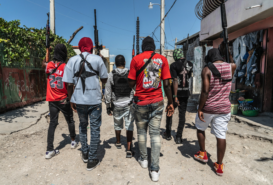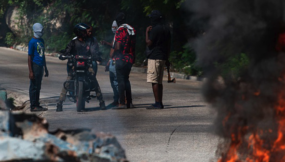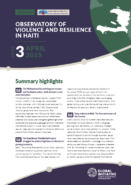In 2024, crime-related violence triggered the displacement of at least 1.2 million people globally – more than twice the number recorded in the previous year. In a report to the Human Rights Council in June 2025, the Special Rapporteur on the human rights of internally displaced persons, Paula Gaviria Betancur, warned of the growing role of organized crime as a catalyst for internal displacement worldwide and as a source of serious human rights violations.
Haiti has emerged as the epicentre of this crisis. The country accounted for approximately three-quarters of all crime-induced displacement in 2024, reflecting the scale and severity of gang-driven security, political and humanitarian collapse currently underway. The situation has continued to deteriorate in 2025. As of July, over 1.3 million people have been internally displaced in the country, an increase of at least 24% since January.
The situation in Haiti is a prime example of how organized crime can systematically drive displacement and transform it into a mechanism of territorial and social control. Displacement in Haiti is not a collateral consequence of insecurity. Rather, it is a calculated component of armed criminal governance – a mechanism for control and domination.
Organized crime remains too often overlooked as a driver of forced displacement. Confronting this reality demands a fundamental shift in how displacement is conceptualized, and how protection strategies, mandates and response mechanisms are formulated. The Haitian case underscores the extent to which criminal actors shape conflict dynamics and humanitarian conditions, requiring stakeholders to adapt frameworks and interventions accordingly.
A new kind of crisis
For the third consecutive year, conditions in Haiti continue to deteriorate. Humanitarian indicators now resemble those of countries engaged in active conflict, with homicide rates placing Haiti among the most violent nations in Latin America and the Caribbean. According to the latest data, around 11% of Haiti’s population are currently displaced within the country, as armed gangs have expanded their territorial control across the capital and towards the Centre and Artibonite departments since April 2025.
Haiti’s crisis is multifaceted and defies traditional classification. Despite the chronic violence and the widespread presence of heavily armed groups, criminal actors are not seeking to seize power in a conventional sense. Instead, they are aiming to infiltrate, manipulate and profit from existing state, economic and social systems.
National and international actors have struggled to prioritize organized criminal actors and their governance practices in their political and technical responses. Consequently, organized crime is all too often treated as a purely technical issue, either delegated to the police or subordinated within broader stabilization frameworks, rather than being addressed as a cross-cutting political, social and humanitarian concern. Yet Haiti exemplifies what we might call a political–criminal crisis, in which organized crime, corruption and illicit economies are not merely symptoms of disorder but key causes of violence and displacement.
Forced displacement as a tool of control
The patterns of internal displacement in Haiti are complex and go far beyond civilians fleeing clashes or seeking to escape generalized violence. Internally displaced persons, particularly women, children and young people, have particular vulnerabilities when criminal groups control territory. Sexual and gender-based violence and coercive control are widespread and are often used as tools of subjugation. Young boys, in particular, are targeted for forced recruitment by criminal groups, putting them at risk of becoming both victims and vectors of violence. The trauma and loss of protection associated with displacement make these populations especially susceptible to exploitation, trafficking and cycles of criminalization.
Thousands of families have experienced multiple displacements over the course of just days or weeks (particularly in the Port-au-Prince metropolitan area) during periods of intensified violence linked to gang territorial expansion. Such was the case during offensives in the Delmas and Solino neighbourhoods in October and December 2024.
Moreover, criminal groups are increasingly using displacement as a strategy to assert territorial and social control. According to research conducted by the Global Initiative Against Transnational Organized Crime (GI-TOC), this approach is implemented by gangs in three distinct but interconnected phases.
The first phase is conquering, characterized by large-scale attacks, including massacres, arson and mass shootings. The aim is to remove both state presence and community resistance. Through forced displacement, gangs are able to establish strategic buffer zones (depopulated and often devastated areas positioned between their strongholds and territories controlled by state forces), providing protection against potential security operations. On 3 July 2025, for example, gang attacks in the area between Mirebalais and Lascahobas, about 30 kilometres from the border with the Dominican Republic, led to the displacement of nearly 30 000 people in just a few days.
Displacement – sometimes occurring within the same neighbourhood or commune, and thus failing to free populations from gang control – tends to be gradual yet persistent, driven by worsening living conditions and social fragmentation. In areas not fully destroyed, gangs may encourage the return of displaced populations to consolidate control. Despite the devastation, the potential loss of housing and the pressures of living under criminal rule, some residents may still choose to return to the areas they had previously fled. Communities in strategic areas such as transport corridors, markets, agricultural zones and water sources – in the Artibonite and the Centre departments, for example – are dispersed under threat of violence and then selectively repopulated on the gangs’ terms.
Finally, a phase of consolidation often follows, during which the return of the population enables gangs to reinforce territorial governance, impose extra-legal systems of taxation, and assert control over humanitarian access, justice and basic service provision. The remaining population is subjected to systematic coercion, including selective killings, sexual violence, the destruction of public infrastructure and manipulation of aid distribution. While displacement tends to slow, it may continue in a more targeted manner – through the selective expulsion of certain families, for example – aimed at neutralizing dissent and reinforcing compliance.
In some instances, according to interviews conducted by the GI-TOC, civilians have been used as human shields, particularly since March 2025, following the Haitian government’s use of drones against gang-controlled areas. This dynamic could also lead to a resurgence of kidnappings, particularly in Port-au-Prince, for the purpose of protection but also as a bargaining chip between gangs and the government.
Throughout this process, displacement is instrumentalized as a tool used to manipulate economic flows, exert political control and manage demographics, a dynamic that must be taken into account in the long term, particularly in the event of general elections. This cycle of violent expulsion, multiple waves of displacement and potential, selective reintegration fractures social cohesion and trust.
Moving beyond traditional approaches
Despite their public statements, the Haitian Transitional Presidential Council, the interim body that exercises the functions of the presidential office until a new president is elected, and the government of Prime Minister Fils-Aimé have yet to implement an effective strategy to address the situation of internally displaced persons. It is of the utmost urgency that the Haitian authorities treat the protection and resettlement of internally displaced persons as a national priority, by developing a comprehensive strategy to address the instrumentalization of population displacement by armed groups, while also accounting for the potential risk of criminal infiltration or exploitation in the management of existing and future displacement camps.
Betancur’s report calls for renewed international attention and urgent reforms to existing protection frameworks to address this escalating global threat. It emphasizes that Haiti is not an isolated case, but rather a warning sign, underscoring the broader regional and international implications of crime-induced displacement. Tackling this crisis will need a wholesale review of the current approaches. Political, humanitarian, development and security stakeholders must unite around a shared understanding of how organized crime operates and the human rights violations it perpetuates, including forced displacement.
Check our event summary on the Protection of internally displaced persons in the context of organized criminal activity.
Un outil stratégique entre des mains criminelles
L’utilisation des déplacements de population comme arme par les gangs en Haïti : un signal d’alarme pour la communauté internationale
En 2024, la violence liée à la criminalité a provoqué le déplacement d’au moins 1,2 million de personnes dans le monde, soit plus du double du nombre enregistré l’année précédente. Dans un rapport présenté au Conseil des droits de l’homme en juin 2025, la Rapporteuse spéciale sur les droits humains des personnes déplacées, Paula Gaviria Betancur, a mis en garde contre le rôle croissant du crime organisé en tant que catalyseur des déplacements internes et source de graves violations des droits humains.
Haïti est devenu l’épicentre de cette crise. Le pays a représenté environ les trois quarts de tous les déplacements induits par la criminalité en 2024, ce qui reflète l’ampleur et la gravité de l’effondrement sécuritaire, politique et humanitaire en cours, provoqué par les gangs. La situation a continué de se détériorer en 2025. En juillet, plus de 1,3 million de personnes étaient déplacées à l’intérieur du pays, soit une augmentation d’au moins 24 % depuis janvier.
La situation en Haïti illustre comment le crime organisé peut systématiquement provoquer des déplacements et les transformer en un mécanisme de contrôle territorial et social. Les déplacements en Haïti ne sont pas une conséquence collatérale de l’insécurité. Il s’agit plutôt d’un élément calculé de la gouvernance criminelle armée, un mécanisme de contrôle et de domination.
Le crime organisé est trop souvent négligé en tant que facteur de déplacement forcé. Pour faire face à cette réalité, il faut changer radicalement la manière dont on conçoit les déplacements et dont on formule les stratégies de protection, les mandats et les mécanismes d’intervention. Le cas haïtien montre à quel point les acteurs criminels influencent la dynamique des conflits et les conditions humanitaires, ce qui oblige les parties prenantes à adapter leurs cadres et leurs interventions en conséquence.
Une nouvelle forme de crise
Pour la troisième année consécutive, la situation en Haïti continue de se détériorer. Les indicateurs humanitaires ressemblent désormais à ceux de pays en proie à un conflit actif, le taux d’homicides plaçant Haïti parmi les nations les plus violentes d’Amérique latine et des Caraïbes. Selon les dernières données, environ 11 % de la population haïtienne est actuellement déplacée à l’intérieur du pays, les gangs armés ayant étendu leur contrôle territorial à la capitale et aux départements du Centre et de l’Artibonite depuis avril 2025.
La crise en Haïti est multiforme et échappe aux classifications traditionnelles. Malgré la violence chronique et la présence généralisée de groupes lourdement armés, les acteurs criminels ne cherchent pas à s’emparer du pouvoir au sens conventionnel du terme. Ils visent plutôt à infiltrer, manipuler et tirer profit des systèmes étatiques, économiques et sociaux existants.
Les acteurs nationaux et internationaux ont eu du mal à donner la priorité aux acteurs criminels organisés et à leurs pratiques de gouvernance dans leurs réponses politiques et techniques. En conséquence, le crime organisé est trop souvent traité comme une question purement technique, soit déléguée à la police, soit subordonnée à des cadres de stabilisation plus larges, plutôt que d’être abordé comme une préoccupation politique, sociale et humanitaire transversale. Pourtant, Haïti illustre ce que l’on pourrait appeler une crise politico-criminelle, dans laquelle le crime organisé, la corruption et les économies illicites ne sont pas seulement des symptômes du désordre, mais des causes fondamentales de la violence et, pour que le sujet qui nous intéresse ici, des déplacements de population.
Les déplacements forcés comme outil de contrôle
Les schémas de déplacement interne en Haïti sont complexes et vont bien au-delà des civils fuyant les affrontements ou cherchant à échapper à la violence généralisée. Les personnes déplacées à l’intérieur du pays, en particulier les femmes, les enfants et les jeunes, sont particulièrement vulnérables lorsque des groupes criminels contrôlent le territoire. Les violences sexuelles et de genre, et le contrôle coercitif sont largement répandus et utilisés comme outils d’asservissement. Les jeunes garçons, en particulier, sont la cible de recrutements forcés par des groupes criminels, ce qui les expose au risque de devenir à la fois victimes et vecteurs de violence. Le traumatisme et la perte de protection associés au déplacement rendent ces populations particulièrement vulnérables à l’exploitation, à la traite et aux cycles de criminalisation. Des milliers de familles ont connu de multiples déplacements en l’espace de quelques jours ou semaines (en particulier dans la zone métropolitaine de Port-au-Prince) pendant les périodes de violence accrue liées à l’expansion territoriale des gangs. Ce fut le cas lors des offensives menées dans les quartiers de Delmas et Solino en octobre et décembre 2024.
De plus, les groupes criminels ont de plus en plus recours au déplacement comme stratégie pour affirmer leur contrôle territorial et social. Selon les recherches menées par la Global Initiative Against Transnational Organized Crime (GI-TOC), cette approche est mise en œuvre par les gangs en trois phases distinctes mais interconnectées.
La première phase est celle de la conquête, caractérisée par des attaques à grande échelle, notamment des massacres, des incendies criminels et des fusillades de masse. L’objectif est d’éliminer à la fois la présence de l’État et la résistance de la communauté. Grâce aux déplacements forcés, les gangs sont en mesure d’établir des zones tampons stratégiques (des zones dépeuplées et souvent dévastées situées entre leurs bastions et les territoires contrôlés par les forces de l’État), qui leur offrent une protection contre d’éventuelles opérations de sécurité. Le 3 juillet 2025, par exemple, les attaques de gangs dans la zone située entre Mirebalais et Lascahobas, à environ 30 kilomètres de la frontière avec la République dominicaine, ont entraîné le déplacement de près de 30 000 personnes en quelques jours seulement.
Les déplacements, qui se produisent parfois au sein d’un même quartier ou d’une même commune et ne permettent donc pas de libérer les populations du contrôle des gangs, ont tendance à être progressifs mais persistants, sous l’effet de la détérioration des conditions de vie et de la fragmentation sociale. Dans les zones qui ne sont pas entièrement détruites, les gangs peuvent encourager le retour des populations déplacées afin de consolider leur contrôle. Malgré la dévastation, la perte potentielle de leur logement et les pressions liées à la vie sous un régime criminel, certains habitants peuvent néanmoins choisir de retourner dans les zones qu’ils ont précédemment fuies. Les communautés situées dans des zones stratégiques telles que les couloirs de transport, les marchés, les zones agricoles et les sources d’eau – dans les départements de l’Artibonite et du Centre, par exemple – sont dispersées sous la menace de la violence, puis repeuplées de manière sélective selon les conditions imposées par les gangs.
Enfin, une phase de consolidation s’ensuit souvent, au cours de laquelle le retour de la population permet aux gangs de renforcer leur gouvernance territoriale, d’imposer des systèmes de taxation extra-légaux et d’affirmer leur contrôle sur l’accès à l’aide humanitaire, à la justice et à la fourniture des services de base. La population restante est soumise à une coercition systématique, notamment des assassinats sélectifs, des violences sexuelles, la destruction des infrastructures publiques et la manipulation de la distribution de l’aide. Si les déplacements ont tendance à ralentir, ils peuvent se poursuivre de manière plus ciblée, par exemple par l’expulsion sélective de certaines familles, afin de neutraliser la dissidence et de renforcer la soumission.
Dans certains cas, enfin, selon des entretiens menés par la GI-TOC, des civils ont été utilisés comme boucliers humains, en particulier depuis mars 2025, à la suite de l’utilisation par le gouvernement haïtien de drones contre les zones contrôlées par les gangs. Cette dynamique pourrait également conduire à une recrudescence des enlèvements, en particulier à Port-au-Prince, à des fins de protection mais aussi comme monnaie d’échange entre les gangs et le gouvernement.
Tout au long de ce processus, le déplacement est instrumentalisé comme un outil servant à manipuler les flux économiques, à exercer un contrôle politique et à gérer des bassins démographiques, une dynamique qui doit être prise en compte à long terme, en particulier en cas d’élections générales. Ce cycle d’expulsions violentes, de multiples vagues de déplacements et de réintégrations potentielles et sélectives fracture la cohésion sociale et la confiance.
Au-delà des approches traditionnelles
Malgré leurs déclarations publiques, le Conseil présidentiel de transition haïtien, organe provisoire qui exerce les fonctions de la présidence jusqu’à l’élection d’un nouveau président, et le gouvernement du Premier ministre Fils-Aimé n’ont toujours pas mis en œuvre de stratégie efficace pour remédier à la situation des personnes déplacées à l’intérieur du pays. Il est de la plus haute urgence que les autorités haïtiennes considèrent la protection et la réinstallation des personnes déplacées à l’intérieur du pays comme une priorité nationale, en élaborant une stratégie globale pour lutter contre l’instrumentalisation des déplacements de population par les groupes armés, tout en tenant compte du risque potentiel d’infiltration criminelle ou d’exploitation dans la gestion des camps de déplacés existants et futurs.
Le rapport de Madame Betancur appelle à un regain d’attention de la communauté internationale et à des réformes urgentes des cadres de protection existants afin de faire face à cette menace mondiale croissante. Il souligne que Haïti n’est pas un cas isolé, mais plutôt un signe avant-coureur, mettant en évidence les implications régionales et internationales plus larges des déplacements induits par la criminalité. Pour faire face à cette crise, il faudra revoir en profondeur les approches actuelles. Les acteurs politiques, humanitaires, du développement et de la sécurité doivent s’unir autour d’une compréhension commune du fonctionnement du crime organisé et des violations des droits humains qu’il perpétue, y compris les déplacements forcés.



